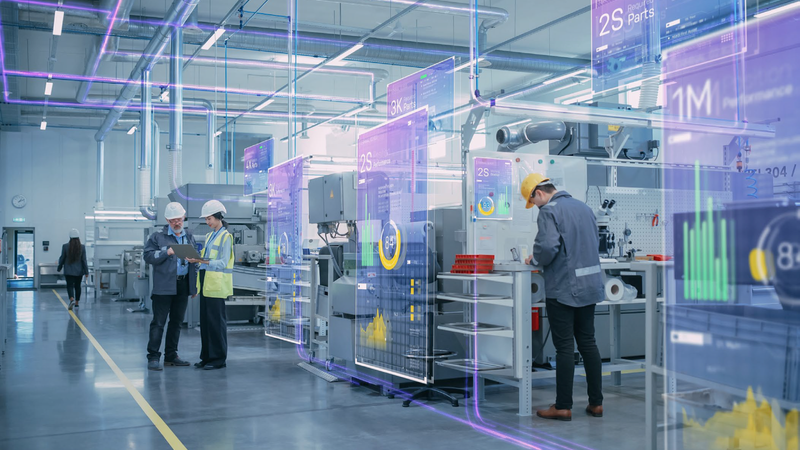The Path to Smarter Manufacturing: 5 AI Trends You Need to Know
Discover how AI is optimizing manufacturing by increasing quality control, reducing downtime and boosting efficiency.
As manufacturers face increasing operational costs, labor shortages, and the need for greater efficiency, AI and Machine Learning (ML) have become critical technologies for driving innovation. The recently released Edge Impulse Manufacturing Dive Survey Report highlights key trends and insights about AI adoption in the manufacturing sector. This article will delve into these findings, exploring how AI is reshaping the industry and why manufacturers should embrace this shift.

The Primary Goal: Optimizing Production with AI
The report's first major finding is that optimizing production stands as the top priority for manufacturers adopting AI. In today's fast-paced market, efficiency is key. AI allows manufacturers to streamline their processes, reduce downtime, and maintain consistent output quality. Through real-time monitoring of production lines, AI algorithms can detect inefficiencies or anomalies long before they affect productivity.
With the advent of edge AI, processing power has moved closer to the source of data, enabling manufacturers to make real-time decisions without relying on cloud connectivity. This not only minimizes latency but also ensures higher privacy and data security, making it an ideal solution for industries requiring rapid, on-site responses.
Quality Assurance: The Dominant Business Driver for AI
Beyond production efficiency, quality control is another driving force for AI adoption. According to the report, 67% of respondents cited product quality as their primary business driver for leveraging AI. Consistent product quality is essential in maintaining a competitive edge and preserving brand reputation. AI and ML models can help manufacturers ensure that products meet high standards by automating inspection processes and identifying potential defects at earlier stages of production.
For example, computer vision integrated with AI can monitor visual anomalies in products, flagging defects with unparalleled speed and accuracy. This technology enables manufacturers to catch and address quality issues in real-time, preventing costly recalls or waste.
Real-Time Insights: Enhancing Safety and Profitability
Another significant takeaway from the report is that manufacturers are increasingly using real-time insights from AI to improve not only profitability but also worker safety. By deploying AI-driven monitoring systems, manufacturers can gather data on equipment health, environmental conditions, and worker behavior to prevent accidents before they happen. In the general market sample surveyed, 62% of respondents indicated that they are likely to implement AI for worker safety.
AI-based predictive maintenance, for example, can predict equipment failures, reducing downtime and maintenance costs while keeping workers safe. This combination of profitability and safety makes AI an indispensable tool in modern manufacturing environments.
The Rise of Edge AI in Manufacturing
Edge AI is a central theme in the report, particularly because of its ability to bring ML models directly to the manufacturing floor. Unlike traditional AI approaches that rely on cloud-based servers, edge AI enables devices at the "edge"—such as machinery and sensors—to process data locally. This shift offers numerous benefits: lower latency, reduced bandwidth requirements, enhanced privacy, and improved data security.
Edge AI is especially valuable in applications requiring immediate action, such as equipment monitoring, process optimization, and environmental tracking. For manufacturers, the ability to act on data as soon as it is generated is critical for maintaining seamless operations and avoiding costly interruptions.
Internal Expertise: The Key to Successful AI Implementation
One of the most notable challenges highlighted in the report is the lack of internal expertise. While AI adoption is on the rise, many manufacturers struggle with integrating AI into their existing workflows due to a shortage of skilled personnel. This underscores the importance of developing a well-rounded, knowledgeable workforce or partnering with AI solution providers who understand the nuances of AI and ML deployment in industrial settings.
The report stresses that to fully realize the potential of AI, manufacturers need to cultivate internal expertise or collaborate with experienced technology partners. Whether it’s training existing employees in AI technologies or hiring dedicated AI specialists, developing internal capabilities is essential for long-term success.
Seizing the AI Opportunity in Manufacturing
AI and ML are set to transform the manufacturing sector in profound ways, from improving production efficiency and quality control to enhancing worker safety and operational resilience. As the report makes clear, manufacturers who can successfully integrate AI into their processes will be well-positioned to thrive in a rapidly evolving industry.
For those looking to stay ahead of the curve, downloading the full Edge Impulse Manufacturing Dive Survey Report is a must. It provides a comprehensive overview of AI’s role in shaping the future of manufacturing and offers actionable insights for those eager to implement AI-driven solutions in their operations.


